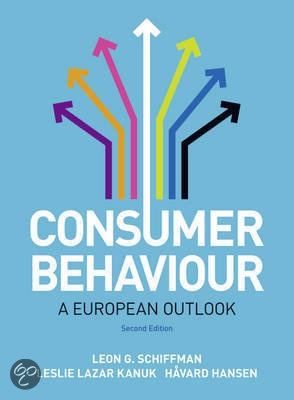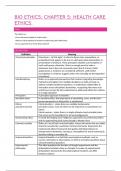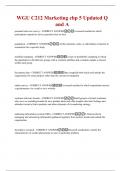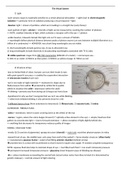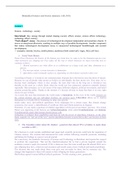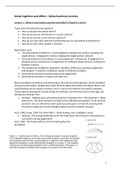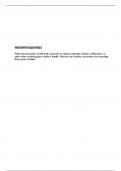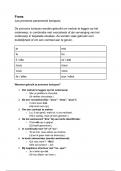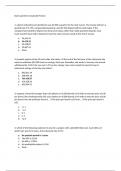Summary 1ZV20
Inhoudsopgave
Chapter 1 – Introduction....................................................................................................................... 2
Chapter 2 – Consumer Research ........................................................................................................... 4
Chapter 3 – Market Segmentation........................................................................................................ 6
Jeff Bray – Consumer Behaviour Theory ............................................................................................... 7
Chapter 4 – Consumer Decision-Making ............................................................................................... 9
Chapter 8 – Consumer Learning.......................................................................................................... 12
Bloch & Richins – A Theoretical Model for the Study of Product Importance Perceptions ................. 16
Chapter 7 – Consumer Perceptions .................................................................................................... 18
Chapter 9 – Consumer Attitude Formation and Change ..................................................................... 21
Wikipedia – Mere Exposure Effect ...................................................................................................... 24
Chapter 15 – Consumer Influence and the Diffusion of Innovations .................................................. 25
Hoyer, MacInnis and Pieters – Low Effort Choice ............................................................................... 28
Peter and Olson – Means-end Chain................................................................................................... 30
Kardes, Cline and Cronley – Heuristics ................................................................................................ 31
Wanke, Bohner, and Jurkowitsch – There Are Many Reasons to Drive a BMW: Does Imagined Ease of
Argument Generation Influence Attitudes? ........................................................................................ 31
Hastie and Dawes – Prospect Theory .................................................................................................. 32
,Chapter 1 – Introduction
Personal consumer: buys goods and services for his own use, for the use of the household or as a
gift. Products are bought for final use by individuals, so end-users. -> focus of the book
Organizational consumer: companies, charities, government agencies and institutions, all who buy
products, equipment and services in order to run their organization.
Development of the marketing concept and the discipline of consumer behaviour
Marketing concept (consumer oriented marketing philosophy): a business orientation that evolved
through several approaches towards doing business referred to the following:
Production concept: assumes that consumer are mostly interested in product availability at low
prices; objectives are cheap, efficient production and intensive distribution. Consumers will buy what
is available rather than wait for what they really want. Objective of companies: expanding the market.
Product concept: assumes that consumers will buy the product that offers them the highest quality,
best performance and most features. Lead to ‘marketing myopia’, a focus on the product rather than
on the consumers’ needs it presumes to satisfy.
Selling concept: a natural evolution from both the production and the product concept. Focus on
selling the product which is produced. Consumers are unlikely to buy the product unless they are
aggressively persuaded to do so, “hard sell” approach. It fails to consider consumer satisfaction.
Selling concept focuses on the needs of sellers, the marketing concept focuses on the needs of buyers.
Implementing the marketing concept
First thing to do is extensive marketing research. The role of consumer research is as follows.
Consumer research: describes the process and tools used to study consumer behaviour. There are
two theoretical perspectives that guide the development.
• Positivists: tend to be objective and empirical, to seek causes of behaviour, and to conduct
research studies that can be generalised to larger populations
• Interpretivists: tend to be qualitative and based on small samples
Then the strategic tools that are used to implement the marketing concept.
Market segmentation: the process of dividing a market into subsets of consumers with common
needs or characteristics. Because most companies have limited resources, few companies can pursue
all of the market segments identified.
Market targeting: selecting one or more of the segments identified for the company to pursue,
Market positioning: developing a distinct image for the product or service in the mind of the
consumer, an image that will differentiate the offering from competing ones and squarely
communicate to consumers that the particular product or service will fulfil their needs better than
competing brands. There are two key principles:
• Communicating the benefits that the product will provide
• The product needs a ‘unique selling proposition’ – a distinct benefit or point of difference
from the similar products on the market.
Marketing mix: consists of a company’s service offerings to consumers and the methods and tools it
selects to accomplish the exchange. 4 elements:
1. The product or service
2. The price
3. The place
4. Promotion
Customer value, satisfaction and retention
There are three drivers of successful relationships between marketers and customers.
Customer value: defined as the ratio between the customer’s perceived benefits (economic,
functional and psychological) and the resources (monetary, time, effort, psychological) used to
obtain those benefits. Developing a value proposition (a term rapidly replacing the popular business
phrase ‘unique selling proposition’) is the core of successful positioning.
Customer satisfaction: the individual’s perception of the performance of the product or service in
2
,relation to his or her expectations. A study that linked levels of customer satisfaction with customer
behaviour identified several types of customers:
• Loyalists: keep purchasing
• Apostles: experiences exceed expectations and positive word-of-mouth
• Defectors: neutral and likely to stop purchasing
• Terrorists: negative experience and spread negative word-of-mouth
• Hostages: unhappy, but stay with company because of monopolistic environment
• Mercenaries: very satisfied, but no loyalty and may defect because of lower prices
Researchers propose that companies should strive to create apostles, raise the satisfaction of
defectors and turn them into loyalists, avoid having terrorist or hostages, and reduce the number of
mercenaries.
Customer retention: makes it in the best interest of customers to stay with the company rather than
switch to another firm. It’s more expensive to win new customers than keeping existing ones. Studies
have shown that small reductions in customer defections produce significant increases because:
1. Loyal customers buy more products;
2. Loyal customers are les price sensitive and pay less attention to competitors;
3. Servicing existing customers, who are familiar with the firms offerings and processes is
cheaper.
4. Loyal customers spread positive word-of-mouth and refer other customers.
Classifying customers according to profitability levels goes beyond traditional segmentation methods
that subdivide consumers on the basis of demographic, sociocultural or behavioural characteristics.
Customer profitability-focused marketing tracks costs and revenues of individual customers and then
categorises them into tiers based on consumption behaviours that are specific to the company’s
offerings. Recent study advocates using a ‘customer pyramid’ where customers grouped into 4 tiers:
1. The platinum tier includes heavy users who are not price sensitive and willing to try new
offerings.
2. The gold tier consists of customers who are heavy users but not as profitable because they
are more price sensitive than those in the higher tier.
3. The iron tier consists of customers whose spending volume and profitability do not merit
special treatment from the company.
4. The lead tier includes customers who actually cost the company money because they claim
more attention than is merited by their spending, tie up company resources and spread
negative word-of mouth.
The impact of digital technologies on marketing strategies
Online communication and emerging digital technologies have introduced several dramatic changes
into the business environment:
• Consumers have more power than ever before. They can use ‘intelligent agents’ to locate
the best prices for products or services, shop around the world, etc. Therefore, marketers must
offer more competitively priced products and more options.
• Consumers have access to more information than ever before. They can easily find
reviews, click button to compare products, etc. Marketers must be aware of the limits of their
promotional message and assume that consumers know all of their buying options.
So marketers can and must offer more services and products than ever before. Thus, marketers can
construct and update their consumer database efficiently and inexpensively. As a result, many
marketers now employ narrowcasting – a method that enables them to develop and deliver more
customised messages to increasingly smaller markets on ongoing basis. Marketers are now investing
their advertising budget in newer media, such as the Web or email.
Marketing ethics and social responsibility
The societal marketing concept requires that all marketers adhere to principles of social responsibility
in the marketing of their target markets in ways that preserve and enhance the well-being of
consumers and society as a whole. The societal marketing concept advocates a long-term perspective.
It recognises that all companies would be better off in a stronger, healthier society, and that
3
, companies that incorporate ethical behaviour and social responsibility in all of their business dealings
attract and maintain loyal consumer support over the long term. Marketing ethics and social
responsibility are important components of organisational effectiveness.
Model of consumer decision-making
Can be viewed as three distinct but interlocking stages:
1. The input stage influences the consumer’s recognition of a
product need and consists of two major sources of information:
o The firm’s marketing efforts (product itself, price,
promotion and where it’s sold)
o The external sociological influences on the consumer
(family, friends, etc.)
The cumulative impact of each firm’s marketing efforts, the
influence of family, etc. and the society’s code of behaviour,
are all inputs that are likely to affect what consumers purchase
and how they use what they buy.
2. The process stage focuses on how consumers make decisions.
The psychological factors (motivation, perceptions, etc) affect
how the external inputs from the input stage influence the
consumer’s recognition of a need, pre-purchase search and
evaluation of alternatives.
3. The output stage of the consumer decision-making model
consists of two closely related post-decision activities:
purchase behaviour and post-purchase evaluation.
Chapter 2 – Consumer Research
In consumer research today we use two types of research methodologies to study consumer behaviour.
• Quantitative: descriptive; predict consumer behaviour; positivism
• Qualitative: depth interviews, focus groups, interpretivism; more interested in the act of
consumers than their buying
Marketers often use a combination of both to help make strategic marketing decisions. The prediction
made possible by quantitative and understanding provided by qualitative.
Consumer Research Process
1. Defining objectives of the research (type and level of info needed)
2. Collecting and evaluating secondary data
Secondary data: any data originally generated for some purpose other than the present
research objectives. Secondary research: locating secondary data. These eliminate the need
for primary research -> very costly.
Syndicated data: data of interest to a large number of users that are collected periodically
and sold to interested buyers. Also customer lifetime value is important for the marketer.
3. Designing primary research study
If description is needed, a quantitative study is likely:
o Observation: best way to get an in-depth understanding of the relationship between
people and products.
- Mechanical: electronic device to record customer behaviour
- Physiological: monitor respondents’ patterns of info processing
o Experimentation: to identify cause and effect
- Controlled: any difference in the outcome is due to different treatments of the
variable under study
- Test marketing: prior to launch a new product
o Surveys: ask customers about their purchase preferences etc.
- Personal interview
- Telephone: less responsive in the weekends; random digital dialling
4
Inhoudsopgave
Chapter 1 – Introduction....................................................................................................................... 2
Chapter 2 – Consumer Research ........................................................................................................... 4
Chapter 3 – Market Segmentation........................................................................................................ 6
Jeff Bray – Consumer Behaviour Theory ............................................................................................... 7
Chapter 4 – Consumer Decision-Making ............................................................................................... 9
Chapter 8 – Consumer Learning.......................................................................................................... 12
Bloch & Richins – A Theoretical Model for the Study of Product Importance Perceptions ................. 16
Chapter 7 – Consumer Perceptions .................................................................................................... 18
Chapter 9 – Consumer Attitude Formation and Change ..................................................................... 21
Wikipedia – Mere Exposure Effect ...................................................................................................... 24
Chapter 15 – Consumer Influence and the Diffusion of Innovations .................................................. 25
Hoyer, MacInnis and Pieters – Low Effort Choice ............................................................................... 28
Peter and Olson – Means-end Chain................................................................................................... 30
Kardes, Cline and Cronley – Heuristics ................................................................................................ 31
Wanke, Bohner, and Jurkowitsch – There Are Many Reasons to Drive a BMW: Does Imagined Ease of
Argument Generation Influence Attitudes? ........................................................................................ 31
Hastie and Dawes – Prospect Theory .................................................................................................. 32
,Chapter 1 – Introduction
Personal consumer: buys goods and services for his own use, for the use of the household or as a
gift. Products are bought for final use by individuals, so end-users. -> focus of the book
Organizational consumer: companies, charities, government agencies and institutions, all who buy
products, equipment and services in order to run their organization.
Development of the marketing concept and the discipline of consumer behaviour
Marketing concept (consumer oriented marketing philosophy): a business orientation that evolved
through several approaches towards doing business referred to the following:
Production concept: assumes that consumer are mostly interested in product availability at low
prices; objectives are cheap, efficient production and intensive distribution. Consumers will buy what
is available rather than wait for what they really want. Objective of companies: expanding the market.
Product concept: assumes that consumers will buy the product that offers them the highest quality,
best performance and most features. Lead to ‘marketing myopia’, a focus on the product rather than
on the consumers’ needs it presumes to satisfy.
Selling concept: a natural evolution from both the production and the product concept. Focus on
selling the product which is produced. Consumers are unlikely to buy the product unless they are
aggressively persuaded to do so, “hard sell” approach. It fails to consider consumer satisfaction.
Selling concept focuses on the needs of sellers, the marketing concept focuses on the needs of buyers.
Implementing the marketing concept
First thing to do is extensive marketing research. The role of consumer research is as follows.
Consumer research: describes the process and tools used to study consumer behaviour. There are
two theoretical perspectives that guide the development.
• Positivists: tend to be objective and empirical, to seek causes of behaviour, and to conduct
research studies that can be generalised to larger populations
• Interpretivists: tend to be qualitative and based on small samples
Then the strategic tools that are used to implement the marketing concept.
Market segmentation: the process of dividing a market into subsets of consumers with common
needs or characteristics. Because most companies have limited resources, few companies can pursue
all of the market segments identified.
Market targeting: selecting one or more of the segments identified for the company to pursue,
Market positioning: developing a distinct image for the product or service in the mind of the
consumer, an image that will differentiate the offering from competing ones and squarely
communicate to consumers that the particular product or service will fulfil their needs better than
competing brands. There are two key principles:
• Communicating the benefits that the product will provide
• The product needs a ‘unique selling proposition’ – a distinct benefit or point of difference
from the similar products on the market.
Marketing mix: consists of a company’s service offerings to consumers and the methods and tools it
selects to accomplish the exchange. 4 elements:
1. The product or service
2. The price
3. The place
4. Promotion
Customer value, satisfaction and retention
There are three drivers of successful relationships between marketers and customers.
Customer value: defined as the ratio between the customer’s perceived benefits (economic,
functional and psychological) and the resources (monetary, time, effort, psychological) used to
obtain those benefits. Developing a value proposition (a term rapidly replacing the popular business
phrase ‘unique selling proposition’) is the core of successful positioning.
Customer satisfaction: the individual’s perception of the performance of the product or service in
2
,relation to his or her expectations. A study that linked levels of customer satisfaction with customer
behaviour identified several types of customers:
• Loyalists: keep purchasing
• Apostles: experiences exceed expectations and positive word-of-mouth
• Defectors: neutral and likely to stop purchasing
• Terrorists: negative experience and spread negative word-of-mouth
• Hostages: unhappy, but stay with company because of monopolistic environment
• Mercenaries: very satisfied, but no loyalty and may defect because of lower prices
Researchers propose that companies should strive to create apostles, raise the satisfaction of
defectors and turn them into loyalists, avoid having terrorist or hostages, and reduce the number of
mercenaries.
Customer retention: makes it in the best interest of customers to stay with the company rather than
switch to another firm. It’s more expensive to win new customers than keeping existing ones. Studies
have shown that small reductions in customer defections produce significant increases because:
1. Loyal customers buy more products;
2. Loyal customers are les price sensitive and pay less attention to competitors;
3. Servicing existing customers, who are familiar with the firms offerings and processes is
cheaper.
4. Loyal customers spread positive word-of-mouth and refer other customers.
Classifying customers according to profitability levels goes beyond traditional segmentation methods
that subdivide consumers on the basis of demographic, sociocultural or behavioural characteristics.
Customer profitability-focused marketing tracks costs and revenues of individual customers and then
categorises them into tiers based on consumption behaviours that are specific to the company’s
offerings. Recent study advocates using a ‘customer pyramid’ where customers grouped into 4 tiers:
1. The platinum tier includes heavy users who are not price sensitive and willing to try new
offerings.
2. The gold tier consists of customers who are heavy users but not as profitable because they
are more price sensitive than those in the higher tier.
3. The iron tier consists of customers whose spending volume and profitability do not merit
special treatment from the company.
4. The lead tier includes customers who actually cost the company money because they claim
more attention than is merited by their spending, tie up company resources and spread
negative word-of mouth.
The impact of digital technologies on marketing strategies
Online communication and emerging digital technologies have introduced several dramatic changes
into the business environment:
• Consumers have more power than ever before. They can use ‘intelligent agents’ to locate
the best prices for products or services, shop around the world, etc. Therefore, marketers must
offer more competitively priced products and more options.
• Consumers have access to more information than ever before. They can easily find
reviews, click button to compare products, etc. Marketers must be aware of the limits of their
promotional message and assume that consumers know all of their buying options.
So marketers can and must offer more services and products than ever before. Thus, marketers can
construct and update their consumer database efficiently and inexpensively. As a result, many
marketers now employ narrowcasting – a method that enables them to develop and deliver more
customised messages to increasingly smaller markets on ongoing basis. Marketers are now investing
their advertising budget in newer media, such as the Web or email.
Marketing ethics and social responsibility
The societal marketing concept requires that all marketers adhere to principles of social responsibility
in the marketing of their target markets in ways that preserve and enhance the well-being of
consumers and society as a whole. The societal marketing concept advocates a long-term perspective.
It recognises that all companies would be better off in a stronger, healthier society, and that
3
, companies that incorporate ethical behaviour and social responsibility in all of their business dealings
attract and maintain loyal consumer support over the long term. Marketing ethics and social
responsibility are important components of organisational effectiveness.
Model of consumer decision-making
Can be viewed as three distinct but interlocking stages:
1. The input stage influences the consumer’s recognition of a
product need and consists of two major sources of information:
o The firm’s marketing efforts (product itself, price,
promotion and where it’s sold)
o The external sociological influences on the consumer
(family, friends, etc.)
The cumulative impact of each firm’s marketing efforts, the
influence of family, etc. and the society’s code of behaviour,
are all inputs that are likely to affect what consumers purchase
and how they use what they buy.
2. The process stage focuses on how consumers make decisions.
The psychological factors (motivation, perceptions, etc) affect
how the external inputs from the input stage influence the
consumer’s recognition of a need, pre-purchase search and
evaluation of alternatives.
3. The output stage of the consumer decision-making model
consists of two closely related post-decision activities:
purchase behaviour and post-purchase evaluation.
Chapter 2 – Consumer Research
In consumer research today we use two types of research methodologies to study consumer behaviour.
• Quantitative: descriptive; predict consumer behaviour; positivism
• Qualitative: depth interviews, focus groups, interpretivism; more interested in the act of
consumers than their buying
Marketers often use a combination of both to help make strategic marketing decisions. The prediction
made possible by quantitative and understanding provided by qualitative.
Consumer Research Process
1. Defining objectives of the research (type and level of info needed)
2. Collecting and evaluating secondary data
Secondary data: any data originally generated for some purpose other than the present
research objectives. Secondary research: locating secondary data. These eliminate the need
for primary research -> very costly.
Syndicated data: data of interest to a large number of users that are collected periodically
and sold to interested buyers. Also customer lifetime value is important for the marketer.
3. Designing primary research study
If description is needed, a quantitative study is likely:
o Observation: best way to get an in-depth understanding of the relationship between
people and products.
- Mechanical: electronic device to record customer behaviour
- Physiological: monitor respondents’ patterns of info processing
o Experimentation: to identify cause and effect
- Controlled: any difference in the outcome is due to different treatments of the
variable under study
- Test marketing: prior to launch a new product
o Surveys: ask customers about their purchase preferences etc.
- Personal interview
- Telephone: less responsive in the weekends; random digital dialling
4


